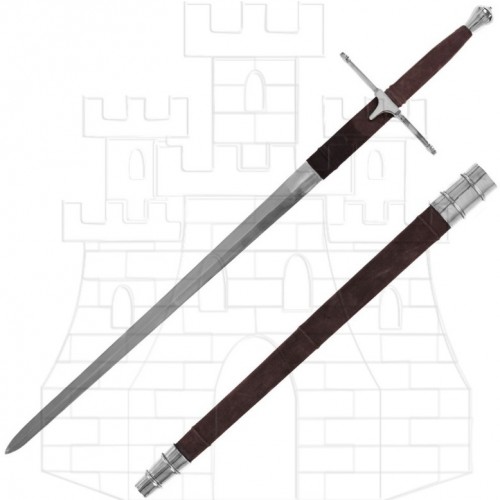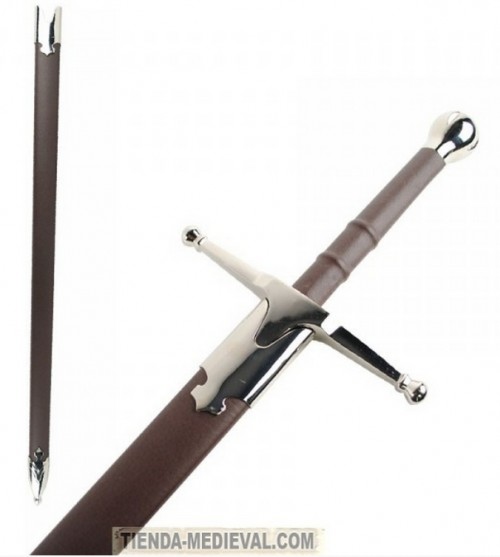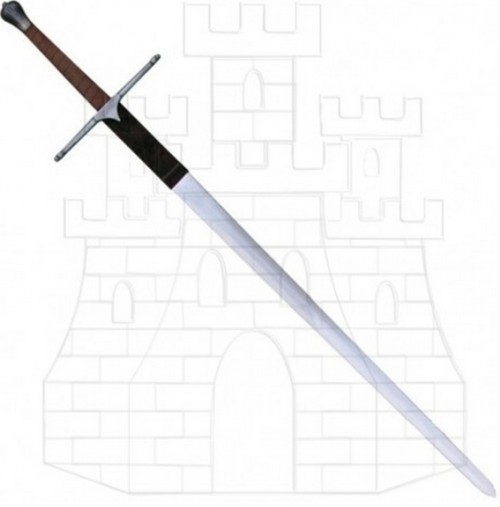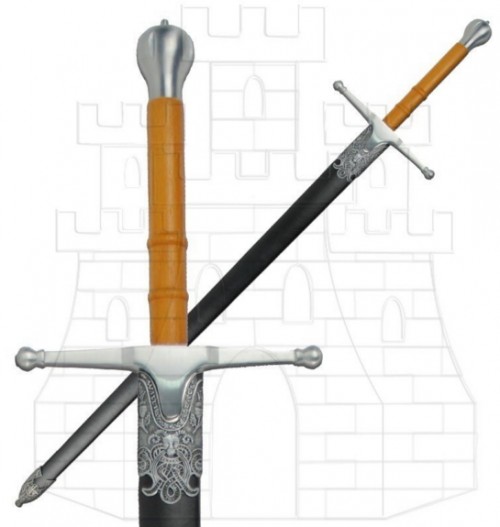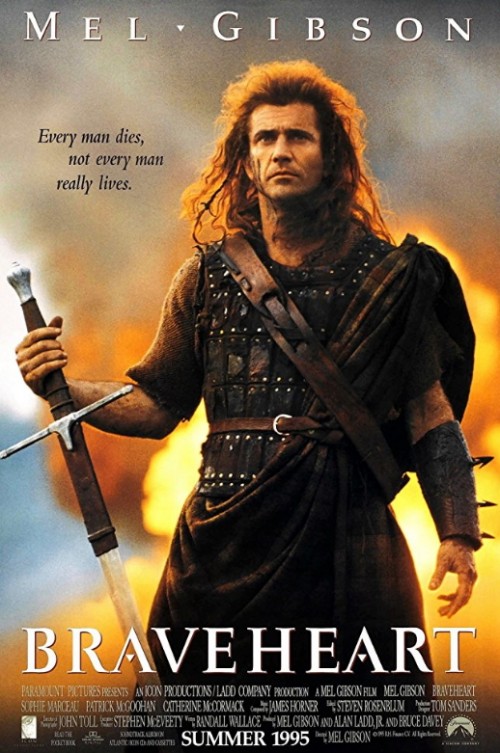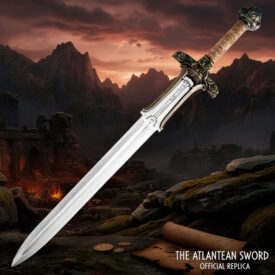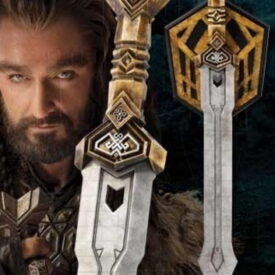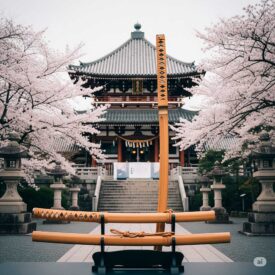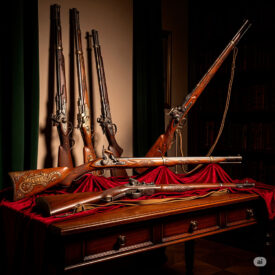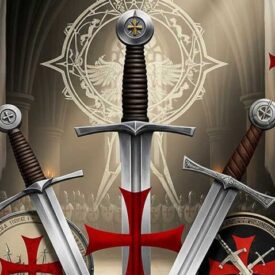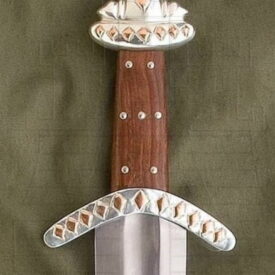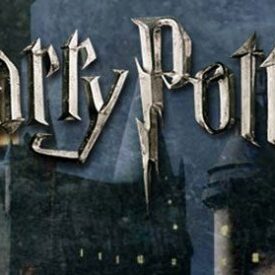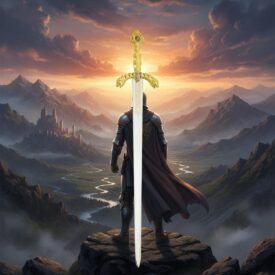What makes the Braveheart sword so recognizable? Is it a cinematic replica, a historical piece, or simply a symbol of freedom? In this comprehensive article, we will analyze everything from the iconography generated by the film to the historical reality behind the legend, as well as offer a practical guide for those looking to buy a quality replica in our store.

The sword on screen and in collective imagination
The movie Braveheart popularized a powerful image: William Wallace wielding a great longsword in large-scale battles. That Braveheart sword we see on screen is not just a weapon; it is a narrative element that reinforces the hero’s figure and instantly conveys power, sacrifice, and rebellion.
It is important to distinguish between the cultural impact and the physical reality of weapons: cinema tends to stylize size, proportions, and finish so that the sword is an easily identifiable symbol. Even so, this aesthetic has generated a sustained demand for replicas that seek to reproduce that iconic look.
Brief history of William Wallace and the legend of his sword
William Wallace (c. 1270–1305) is a figure that mixes historical documentation with myth. A leader in the struggle for Scottish independence in the late 13th century, his legend was fueled by victories such as Stirling and his execution in London, events that turned him into a national symbol.
The so-called “Wallace Sword” has been the subject of many stories and attributions. Some accounts describe it as a huge longsword (or claymore according to tradition) that, due to its size, raises doubts about its actual use in combat. Even so, the idea of the Braveheart sword remains an emblem of resistance.
Chronology of the sword attributed to William Wallace
Chronological summary of facts, appearances, and references about the sword associated with William Wallace.
| Period / Date | Brief Description |
|---|---|
| Mid-13th century | The “great war sword” (Oakeshott Type XIIIa), the type traditionally associated with Wallace, becomes common. |
| 1270 | William Wallace’s birth in Elderslie, Scotland. |
| 1296 | Wallace attacks an English detachment in Ayr, killing several soldiers; he is captured and imprisoned but manages to escape. |
| 1296–1357 | Period of the Scottish Wars of Independence, general context of the sword’s use and legend. |
| May 1297 | Wallace kills the person responsible for his father’s death and becomes an outlaw; he begins his campaign against the English. |
| August 1297 | Sir Andrew de Moray joins Wallace; combined forces defeat the English army of the Earl of Surrey at the Battle of Stirling Bridge. It is claimed that Wallace’s sword was used there. |
| 1298 | Wallace’s defeat at the Battle of Falkirk; it is also said that the sword was used in this encounter and is believed to have been in use at least until then. |
| 1305 | William Wallace is captured and handed over to the English by John de Menteith; executed in London. After the execution, it is alleged that Menteith received the sword, although there are no firm records; legend places the sword in Dumbarton Castle. |
| Shortly after 1305 | Robert Bruce rallies the Scots and advances towards Scotland’s independence; the sword becomes intertwined with the legendary memory of the conflict. |
| Second half of the 15th century | The Scottish epic poem The Wallace (attributed to Blind Harry) is written, one of the main sources, albeit with historical additions. |
| 1475 | The sword of the County Palatine of Chester, similar to the mountings attributed to the Wallace Sword, was used by Edward IV, Prince of Wales (a comparative reference later used to date mountings). |
| 1505 | First documented record of the sword: King James IV pays 26 shillings for repairs (new silk binding, hilt, pommel, scabbard, and belt). Rumors circulate about pieces made from Sir Hugh Cressingham’s dried skin. |
| 1617 | The Wallace Tower is erected at Dumbarton Castle. |
| 1644 | A sword matching the traditional description of the Wallace Sword appears in the Wallace Tower at Dumbarton Castle. |
| 1803 | The modern association of the sword with Wallace is first documented: William Wordsworth is informed by a soldier in Dumbarton that it is the warrior’s sword. |
| 1808 (or earlier) | The sword is publicly advertised as the Wallace Sword in Dumbarton Castle. |
| 1825 | The sword is allegedly sent to the Tower of London for repairs; the Duke of Wellington commissions an examination by Sir Samuel Meyrick, who determines that the mountings date from the 15th century (without evaluating the blade). |
| 1860 | Construction of the National Wallace Monument in Stirling begins. |
| 1869 | The National Wallace Monument opens to the public. |
| 1875 | Charles Rogers attempts to move the sword to the Monument; the request is rejected by the Colonel of the Royal Artillery at Dumbarton Castle. |
| October 15, 1888 | After years of requests, the War Department authorizes the transfer of the sword from Dumbarton Castle to the National Wallace Monument in Stirling; the decision causes protests in Dumbarton. |
| Late 1888 | The sword is displayed in a large glass urn in the Hall of Heroes at Stirling Monument, where it has remained ever since (with subsequent interruptions for thefts and restorations). |
| 1912 | Suffragette Ethel Moorhead breaks the sword’s display case at the Monument to draw attention to women’s suffrage. |
| 1930 | The so-called “last sword” of William Wallace, supposedly preserved in Loudoun (Ayrshire), is sold at a private auction in Glasgow and its whereabouts are lost. |
| November 8, 1936 | The sword is stolen from the Monument by student nationalists from the University of Glasgow; they return it upon realizing the discomfort it caused. |
| May 1972 | The sword is stolen again. |
| October 1972 | The sword is returned to the Monument. |
| 2005 | The sword is lent to New York for exhibition at Grand Central Terminal during Tartan Week; it is the first time in modern history it has left Scotland for exhibition. |
| 2007 | The Wallace Book, edited by Edward J. Cowan, which addresses Wallace’s figure and iconography, is published. |
| December 2021 | The article “Where is the mythical sword of William Wallace located?” by Santiago Cravero is published in Intriper. |
| March 2, 2023 | Activists from the “This Is Rigged” group vandalize the sword’s display case at the National Wallace Monument; the sword is temporarily removed for safety. |
| March 2023 | A new display case for the sword is commissioned, with a reported cost of £10,000. |
| May 2023 | The sword returns to the National Wallace Monument and is re-exhibited in the new display case. |
How did Braveheart influence the perception of the sword?
The movie strengthened certain visual features: long blades, simple guards, and robust pommels. Many commercial replicas take this cinematic aesthetic as a reference, but there are variations depending on whether the piece is decorative or functional.
If you are a fan of reproductions, understanding this difference will help you define expectations before buying and evaluate technical specifications such as blade material, overall length, and hilt construction.
Historical reality versus cinematic representation
The sword that appears in Braveheart is a stylized version: films seek visual impact and not always technical fidelity. From size to balance and materials, the cinematic sword is designed to be photogenic and convey character to the protagonist.
Nevertheless, there is a very well-known historical sword attributed to Wallace that has fueled the confusion between the real and the legendary. Although the authenticity of this piece is debated by historians, its presence in public imagery has served as a basis for many replicas.
The most common myths
- Impossible size: many reproductions exaggerate the length for visual effect; large historical swords exist, but their use had practical limitations.
- Magical materials: in cinema, appearance matters; in reality, what defines quality is the steel and forging.
- Mounted use: a long longsword would be difficult to use from horseback; weapon typology evolved according to real combat tactics.
The sword attributed to William Wallace: findings, repairs, and controversies
The piece traditionally associated with Wallace has a complex history: intermittent records, possible repairs in the 16th century, and modern questions about its authenticity. Research indicates that some mountings were added centuries later, which complicates the claim that it is the original 13th-century weapon.
The debate on authenticity includes physical observations: considerable weight, later assemblages, and proportions that would make its regular use improbable. Experts have noted that the blade may have been composed of welded pieces, which questions its integrity as an unaltered relic.
What studies tell us
Recent investigations emphasize that many elements of the sword could correspond to enlargements or mountings from different eras. This does not eliminate its symbolic value, but it does relax the assertion that it is the exact sword wielded by Wallace in the battles of the late 13th century.
Regardless of its origin, the narrative surrounding this sword has had a strong cultural impact and has served as inspiration for modern replicas and collections.
Braveheart Swords: replicas, materials, and available types
In the current market, Braveheart swords are presented in two main categories: decorative and functional. Each one caters to a different audience and use.
Characteristics of decorative replicas
- Material: usually stainless steel or alloys with an aged finish.
- Length: usually respects cinematic aesthetics (114–155 cm).
- Finish: ornamental details, synthetic leather-wrapped handles, and decorative scabbards.
- Usage: decoration, collection, wall display, or themed events.
Characteristics of functional replicas
- Material: carbon steel or steels suitable for tempering and sharpening.
- Construction: full forge, rivets, reinforced tang for strength.
- Length and balance: designed to be maneuverable and safe in controlled practices.
- Usage: historical reenactment, controlled cutting, practice of HEMA (Historical European Martial Arts).
Many reference manufacturers produce models in Spain (especially Toledo), where the smithing tradition guarantees careful finishes and personalized options.
How to choose a Braveheart sword replica
Choosing a suitable replica depends on several factors: purpose, budget, and aesthetic preferences. Here is a practical guide:
- Define your use: decoration or realistic fencing. If it’s for display, prioritize appearance; if it’s for use, prioritize materials and construction.
- Measure space and proportions: a 140–155 cm sword is impressive, but make sure you have space to display it or handle it safely.
- Look at the steel: stainless steel is easy to maintain; carbon steel is harder and suitable for sharpening, but requires care against corrosion.
- Check the hilt: a good hilt is ergonomic and well-fixed. If the piece has historical details, value the mountings and rivets.
- Ask for tang information: a full tang is preferable for functionality and strength.
If you need specific recommendations, in our store you will find both decorative and functional models, with clear technical specifications and quality guarantee.
Maintenance and conservation of a Braveheart replica
To keep your replica in good condition, follow these basic guidelines:
- Avoid prolonged humidity; store in a dry environment.
- Apply a coat of protective oil to carbon steel blades after handling.
- Clean stainless steel with a soft cloth and avoid strong abrasives.
- Periodically check rivets and hilts; tighten or repair loose mountings.
Simple maintenance extends the useful life and maintains the cinematic appearance that characterizes the Braveheart sword.
Legal aspects and safety
Before buying or carrying a replica, check local regulations on bladed weapons. In many countries, decorative swords are legal to collect, but their public transport or exhibition at events may require specific permits or safety measures.
For use in reenactment or practice, always perform activities in controlled environments and with adequate protection. Never use a sharpened replica without the necessary training and authorizations.
Historical and symbolic value: why the Braveheart sword matters
Beyond authenticity, the Braveheart sword functions as a symbol. It represents resistance against oppression and has served as a cultural emblem for centuries. This symbolic value explains why collectors and enthusiasts seek replicas that convey the same emotion as the movie and the legend.
Where to buy quality replicas
If you are looking for a reliable replica, prioritize stores with complete technical specifications, good reviews, and clear return policies. Always check:
- Specifications: material, overall length, blade length, and tang type.
- Customer reviews and real photographs.
- Warranty and after-sales service.
VIEW BRAVEHEART SWORDS | VIEW CLAYMORE SWORDS | VIEW MORE WILLIAM WALLACE SWORDS | VIEW SCOTTISH SWORDS
